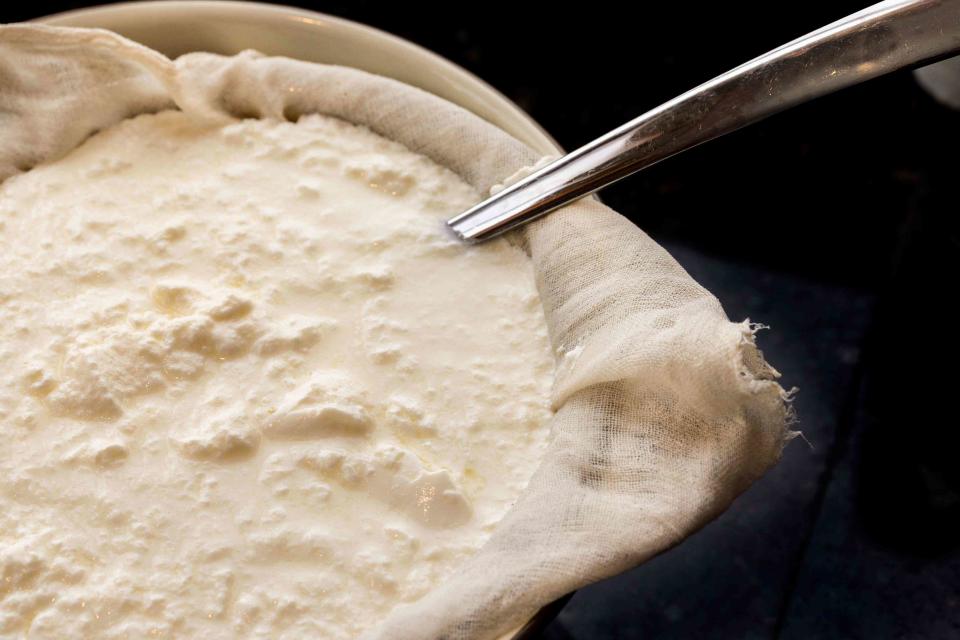How to Use Yogurt Whey in Marinades and so Much More
Homa Dashtaki explains why this often discarded ingredient is liquid gold.

Malisa Nicolau / Alamy Stock Photo
You've probably heard of whey from nursery rhymes, when we find Little Miss Muffet sitting on her tuffet eating her curds and whey. But, what exactly is Little Miss Muffet eating? To answer that question, we asked Homa Dashtaki, founder of The White Moustache, a small-batch handmade and hand-strained yogurt company and author of Yogurt & Whey: Recipes of an Iranian Immigrant Life to answer the big question: What is whey?
What is whey?
Simply put, whey is the leftover liquid after milk has been curdled and strained. It is full of various proteins. We’ve got two primary categories for whey: sweet and acid. Sweet whey is the strained liquid from hard cheeses and acid whey is the strained liquid from soft cheeses and yogurt. While Miss Muffet was likely enjoying some form of cheese whey, yogurt whey is something you’re probably more familiar with. “Yogurt whey is the liquid yin to the solid yang you are used to seeing in your Greek yogurt,” says Dashtaki. To get the thick, decadent Greek yogurt you know, traditionally we need to strain out the liquid (whey) from it. It is a neon yellow, beautifully silky elixir that results from making strained yogurt.”
How to make and store yogurt whey
Don’t panic if you don’t see a jar of yogurt whey at the grocery store. It’s simple to make at home; all you need is any brand of plain, unstrained yogurt, a fine mesh cloth or clean tea towel, a colander, and a big bowl. Line the colander with the mesh cloth or towel and place the prepared colander into a large bowl. You’ll want a big enough bowl so the colander is ideally suspended at least two to three inches from the bottom. Spoon your yogurt into the colander and fold the edges of the mesh cloth or towel over the top of the yogurt. Pop the bowl in the refrigerator and watch as time does the work for you. The whey will separate itself from the yogurt within a few hours. It’s that simple! Yogurt whey can be stored just like regular yogurt, covered in an airtight container in the refrigerator for up to three weeks.
How to cook with yogurt whey
Before you begin cooking with yogurt whey, you should understand what it tastes like (and yes, it does have a flavor). “It tastes like a brighter, lemony version of plain yogurt. It’s just pure tang brightness,” says Dashtaki. This bright and zippy flavor profile makes cooking with yogurt whey ideal for a lot of recipes. For extra tang with tenderization, add yogurt whey to marinades like Homa’s Yogurt-Marinated Pork Chops with White-Wine Shallot Sauce, Cheetie Kumar’s aromatic Spiced Yogurt Marinade, or Tom Mylan’s Yogurt-Marinated Grilled Chicken.
It’s no secret that adding yogurt to baked goods gives them extra moisture, but you can get the same results with yogurt whey as well, for recipes like Hetal Vasavada’s Cardamom Yogurt Cake with Mango Lassi Icing or Grace Parisi’s Yogurt-Zucchini Bread with Walnuts.
But yogurt whey does not have to be limited to being a yogurt substitute. “Anywhere you use water, buttermilk, or milk, I would try experimenting with whey in a 1:1 ratio. It’s slightly more dense than water but less dense than milk or buttermilk,” says Dashtaki. Her biggest piece of advice? “Experiment, experiment, experiment. Look in your pantry for what other bonus ingredients are hiding in plain sight. Maybe something you are throwing out is a gold mine of flavor.”
For more Food & Wine news, make sure to sign up for our newsletter!
Read the original article on Food & Wine.

